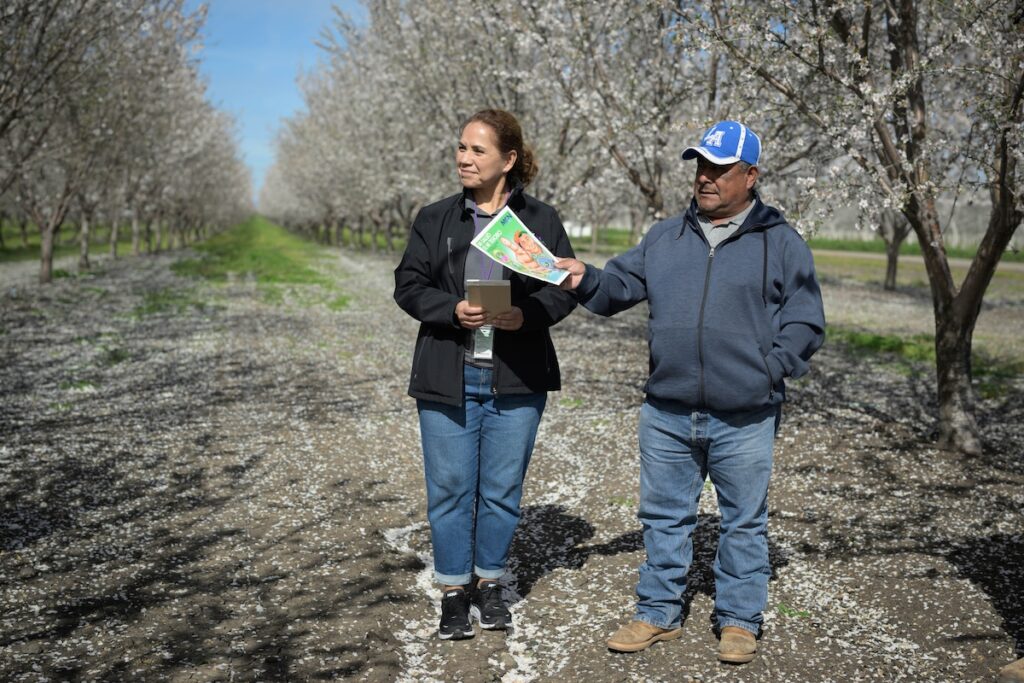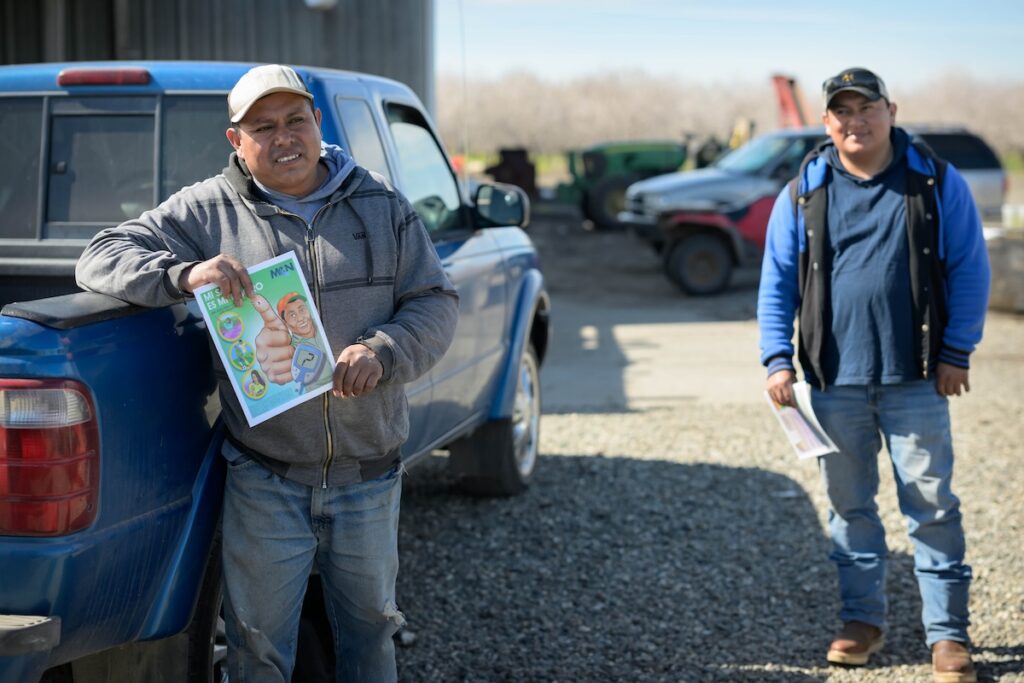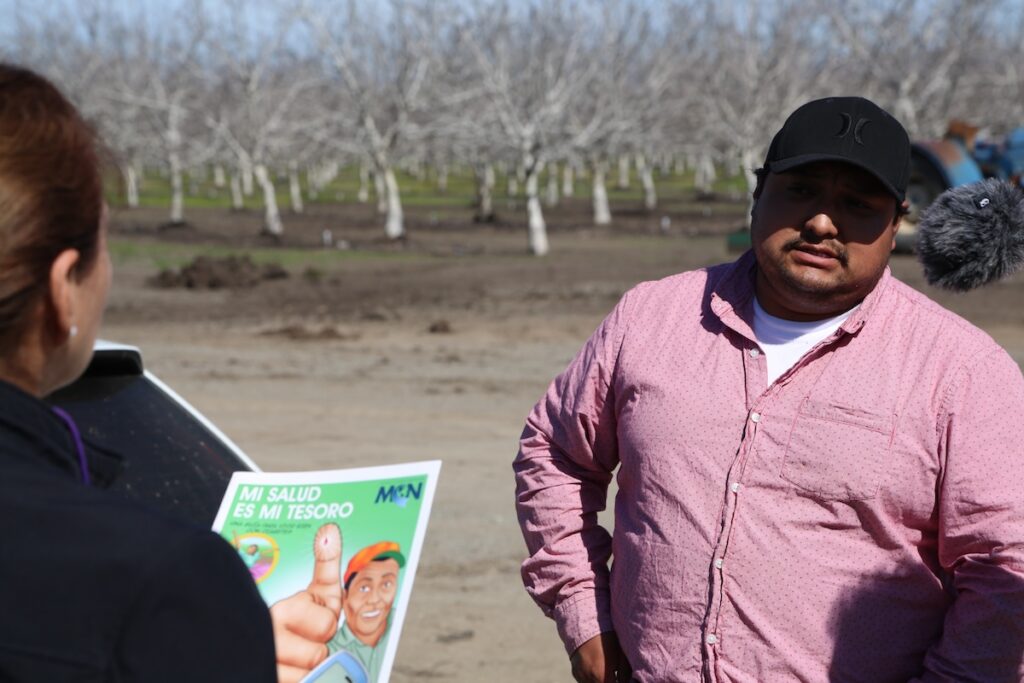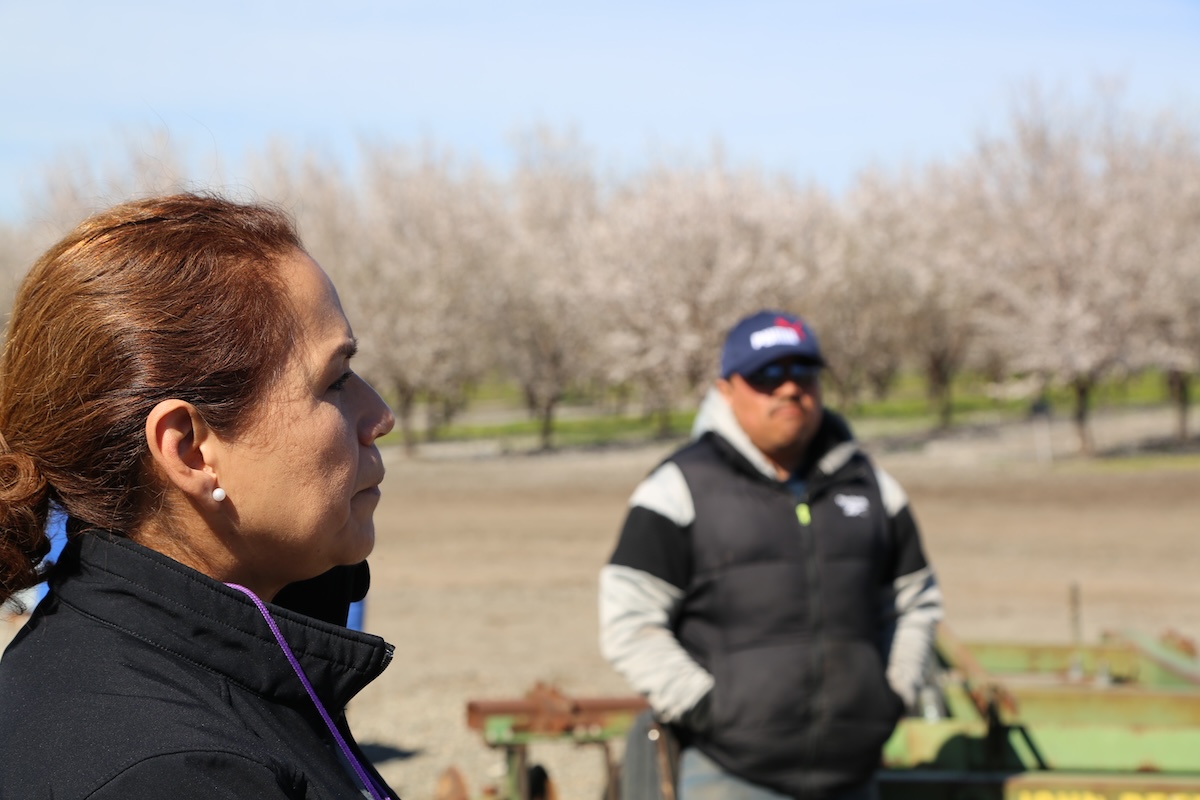Above: As a promotora for Ampla Health, Maria Soto is at the forefront of expanding Medi-Cal access across six counties in California’s rural north. (Credit: Peter Schurmann)
HAMILTON CITY, Calif. – It’s late February and the road to Hamilton City, an agricultural community about 10 miles west of Chico, is lined with blooming almond trees, their pink blossoms blanketing the fields for miles around. A single clinic stands in the center of town.
Inside the clinic we meet Maria Soto, whose work as a promotora is an essential piece in California’s ambitious plan to deliver healthcare to all residents regardless of immigration status.
“I identify very much with the community,” says Soto, 57. “I worked in the fields, harvesting and sorting nuts here. So, I love it. It gives me a lot of satisfaction when someone says, ‘Thank you for helping me.’ This for me is invaluable.”

Soto is one of four promotoras (individuals who provide basic health education to the community) with the non-profit healthcare provider Ampla Health, which operates more than a dozen clinics across six counties – Glenn, Butte, Colusa, Sutter, Tehama and Yuba – in California’s rural north. As a Federally Qualified Health Center, Ampla Health is tasked with expanding access to Medi-Cal (California’s version of Medicaid) across the entirety of its jurisdiction.
That job took on added importance as of January 1, when undocumented immigrants ages 26-49 became eligible for the program. Earlier expansions targeted both older adults and children. This latest phase makes California one of the first states in the country to offer healthcare to all eligible residents.
With nearly 16 million enrolled – or one out of every three Californians – Medi-Cal is the nation’s largest Medicaid provider. With the current expansion the state expects to add an additional 500,000 to 700,000 to its list, at a cost of some $2.6 billion per year. Medi-Cal’s total annual operating budget tops $37 billion.
Eligibility is based on income, with the upper limit for an individual set at $21,680 per year, with approximately another $7,100 for every additional member of the household. Medi-Cal covers medical, dental and vision services.
The challenge now is making sure those communities who stand to benefit are informed about the opportunities available, which in California’s far north is easier said than done.
Accessing healthcare ‘without fear’
We’re standing in an open field of almond trees, on a farm about 30 minutes outside Hamilton City. Around us a group of about a dozen farmworkers is gathered, all originally from the same community in the state of Puebla, Mexico.
“She came and interrupted our work once,” jokes Elfego Palestino Vidal gesturing towards Soto. “I never enrolled before,” he says, adding that in recent years he’s seen more of his coworkers fall ill because of the increasingly extreme weather. “Sometimes it gets very cold, it rains a lot, then it gets very hot.” Having access to Medi-Cal will “help a lot,” he says.

Famed for its sprawling forests, towering peaks and rugged coastline, the North State, as it’s known – stretching from the Oregon border in the north to just above Sacramento farther south – is beset by some of the state’s most glaring health disparities, from higher rates of poverty and premature death to substance abuse, and behavioral and mental health challenges.
Much of the region is also designated as a Health Provider Shortage Area (HPSA), meaning fewer healthcare resources per capita. For marginalized communities, including many of the farmworkers interviewed for this story, that creates additional barriers to accessing care.
Another farmworker, Leonardo Hernandez Mesa, a husband and father of two, describes how he put off visiting the doctor in the past when he fell ill. He points to his throat and ear as he recalls a recent bout of infections. “Emergency visits are too expensive,” he says, noting that his brother – also a farmworker – has Type 1 Diabetes.
“This is a great opportunity to get health insurance without fear,” says Hernandez, adding that it will allow people to detect health issues earlier rather than later. He says he’s often heard others talk about putting off hospital visits.
A study from UC Merced last year found that nearly half of all farmworkers in California lacked health insurance at some point over the previous 12 months. The study also found that just 43% of farmworkers had visited a doctor’s office while only 35% had been to a dentist. Other studies have found a stark disparity in access to mental health and other behavioral services for farmworkers in particular.
Simon Vazquez, who has worked at the same farm in Hamilton City for over two decades and is the foreman here, hasn’t seen a doctor since 2018. He peppers Soto with questions about where and how to contact her, whether he needs to renew every year (you do), and what he needs to bring for a medical or dental visit (a photo ID and Medi-Cal card).
“We’re here to help you with whatever questions you have. You have my information, you have my phone number,” she says patiently.
Reaching the ‘hardly reached’
“A big part of my day is driving around looking for farmworkers,” explains Soto, who came to the US as an undocumented immigrant herself in 1991 and spent time working in the almond fields surrounding Hamilton City. In 2007, she began working with Ampla Health, then known as Del Norte Clinics, after a chance meeting with the organization’s promotora coordinator at a local Mexican eatery.
“She asked me what I knew about being a promotora. I told her I didn’t know anything.” Soto eventually applied, was given training, and has been committed to promotora work ever since. “I’ve fallen more in love with the work as the years have passed,” she says.

The promotora model was first developed in the northern Mexican city of Ciudad Juarez in the early 1970s as a way for the city government to deliver healthcare and related information to marginalized communities. The model soon spread across Latin America, later making its way into the US.
It’s unclear how many promotoras are currently working across California. Some, like Soto, are employed directly by healthcare providers or community organizations. Others work in more informal capacities. The advocacy group Visión y Compromiso, which launched the state’s first network of promotoras in 2001, claims some 4,000 members across 13 regions of California, almost all of them in the southern and central parts of the state where population numbers are larger and overall demand for services greater.
According to data from UC Davis’s Center for Reducing Health Disparities, there are an estimated 10,000 farmworkers across the six counties served by Ampla Health. If their family members are included, that number jumps to nearly 30,000 individuals. While it’s unclear how many are undocumented, data shows that nearly three quarters of the more than half a million farmworkers in California lack documentation.
Dr. Sergio Aguilar-Gaxiola, who heads the Center for Reducing Health Disparities, calls these communities “hardly reached,” and says local and state agencies have to be proactive in terms of getting the word out. “I’m not sure if they will take advantage of this ,” he said during a recent Ethnic Media Services briefing. “It depends on how you communicate.”
A ‘tremendous need’
Aguilar-Gaxiola, who has spent decades researching health inequities impacting California’s farmworker population, points to a range of barriers – from language and culture to fear of deportation – that prevent many from coming forward to access available resources.
“This is a tremendous need,” says Aguilar-Gaxiola. “Meeting it requires more than goodwill and wanting to do the right thing. In order to reach these populations, building trust is front and center.”
During the Trump administration a law known as the Public Charge Rule, which threatened deportation for migrants accessing public benefits, cast a shadow of fear over the community. While essentials like healthcare and food are not considered part of a public charge determination, many immigrants continue to be fearful of enrolling in public programs like Medi-Cal.

“People will be hesitant to enroll into Medi-Cal due to the fear of public charge,” agrees Cynthia Peshek, outreach program manager with Ampla Health. “We need to ensure that this is not the situation. They need to go ahead and tap into these resources. There will still be those who don’t want to take a chance, therefore public charge may still be a barrier for some.”
Ampla Health organizes local health fairs and other community events in addition to working with promotoras as part of a suite of strategies aimed at connecting people to healthcare. But Peshek is concerned that providers in other counties where resources are more limited may not have the necessary resources to deliver on this current expansion. “It’s going to be a big undertaking,” she says.
Peshek points out that Ampla Health recently added two new clinics to its existing network to meet growing demand. “There is just so much opportunity right now,” she notes. “We need to get the word out in all of the areas that we serve.”
Back at the farm, another in the group, Daniel, says he’s not currently covered. He’s young, in his mid-20s. He says he’s visited Ampla Health in the past and that he now wants to enroll to avoid the high costs of medical services and any medicines he may need. “It’s a big help.”
As we depart, he nods toward Soto. “Thank you for being here. Thank you for not forgetting about us.”
This article was supported by the USC Annenberg Center for Health Journalism’s 2024 California Health Equity Impact Fund. With additional reporting by Manuel Ortiz.













